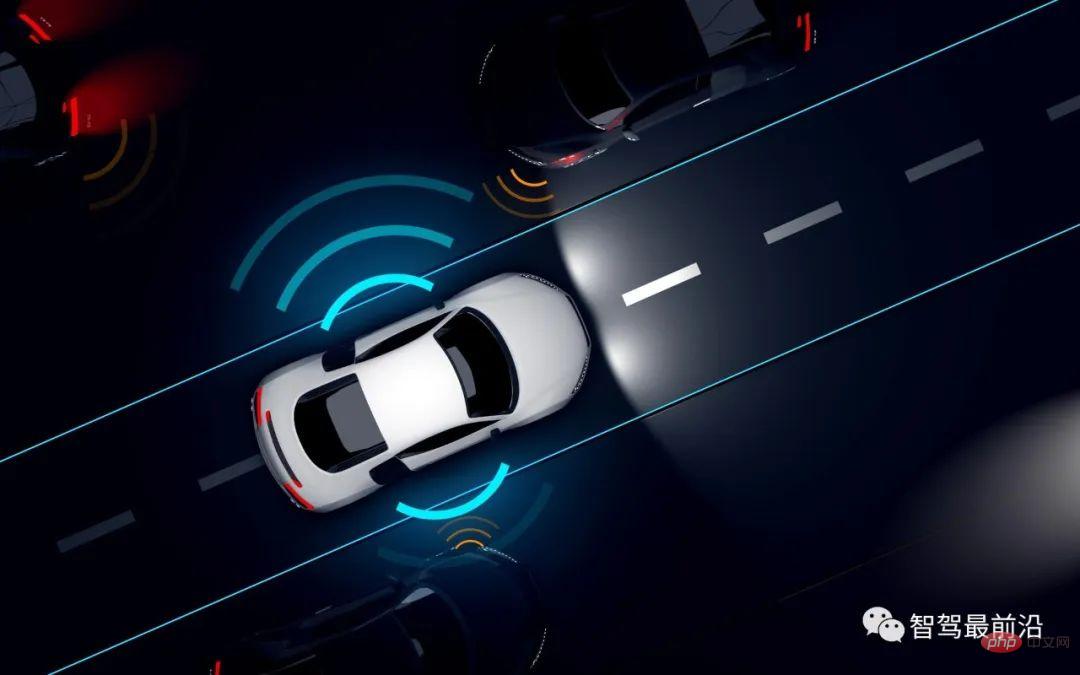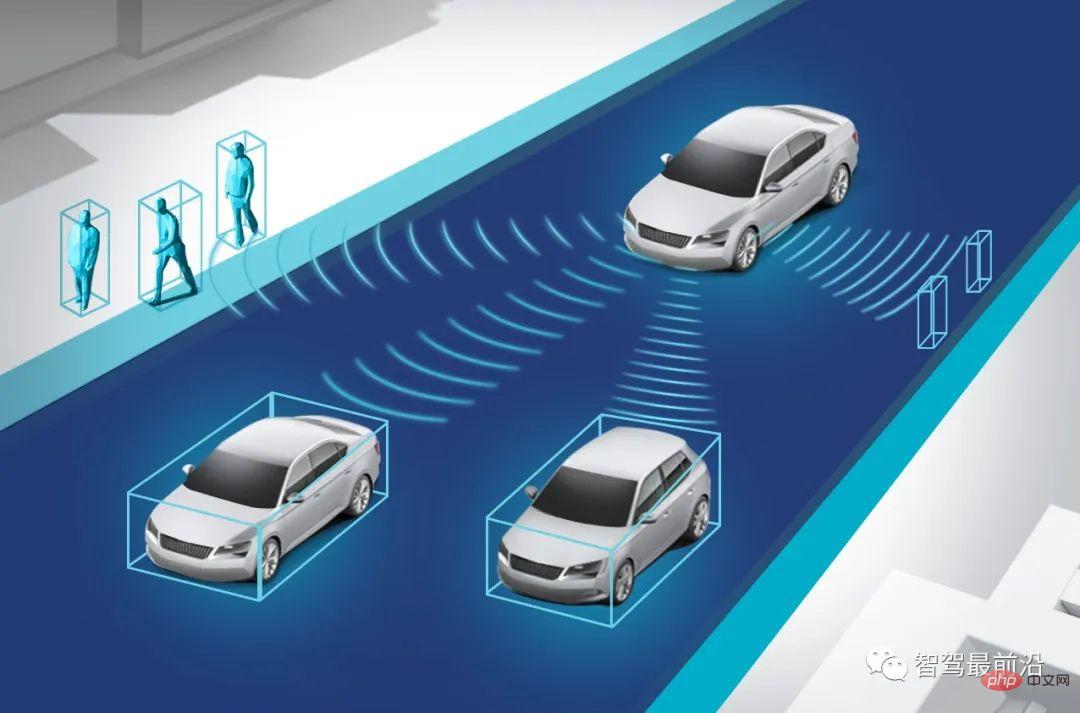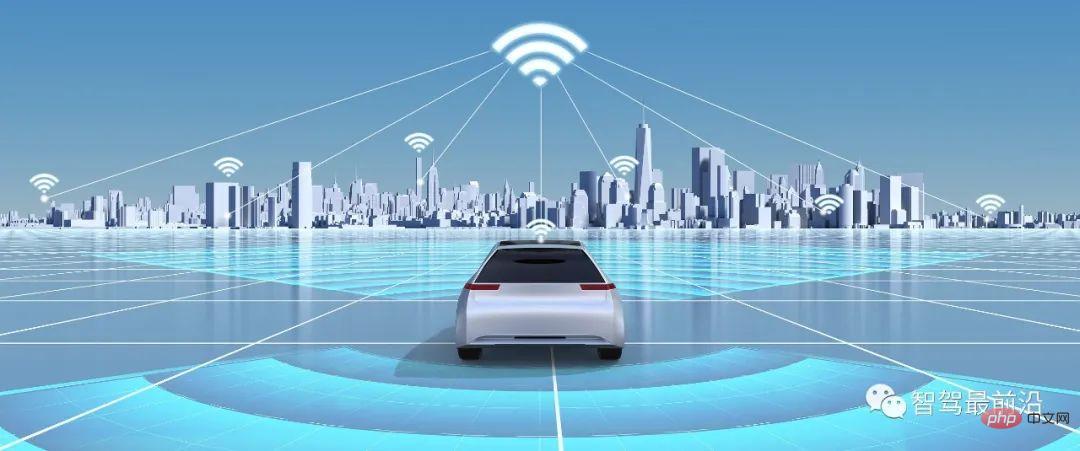An article about autonomous driving decision-making systems
Autonomous driving is a system that integrates perception, decision-making, and control and fully considers the coordinated planning of vehicles and the traffic environment. It is also an important component of future intelligent transportation systems. Just as people need to know the road conditions, understand the direction, avoid obstacles in time, and reach their destination when walking, perception, decision-making, and control are also very important for self-driving cars.
Perception is just like human eyes and ears. By installing hardware equipment such as millimeter wave radar, lidar, and vehicle cameras on self-driving cars, self-driving cars can see To clear the road conditions, the perception system can detect lane lines, vehicles, pedestrians and other traffic participants through perception hardware. The core of its technology is the accuracy of perception hardware detection and the integration of perception results by multiple perception hardware.

Decision-making is like the brain, which can analyze the road conditions and make the next step. Control is to allow the self-driving car to act according to the The brain (decision-making) analyzes the results and takes action. Decision-making can be understood as making judgment decisions based on perceived information, determining an appropriate working model, and formulating corresponding control strategies, which can replace the driver in making further driving decisions.
According to the classification of the Society of Automotive Engineers, autonomous driving is divided into 6 levels from L0 to L5. As the level of autonomous driving continues to improve, autonomous vehicles become more intelligent. Comprehensive, after reaching L5 level, self-driving cars can complete driving actions independently without the need for a driver to operate the car. The improvement of autonomous driving levels mainly reflects the technological improvement of decision-making systems.
Control is like human hands and feet. It controls and executes specific travel actions, allowing self-driving cars to complete the travel process. The control system can complete the turning and acceleration of the vehicle. , lighting control and a series of actions are the final step to realize autonomous driving.
As mentioned above, the decision-making system is like the human brain, which can control the speed, direction and lights of self-driving cars. The smarter the decision-making system, the better the self-driving car. The higher the achievable level. In traditional understanding, the decision-making system covers environmental prediction, action planning, path planning, behavioral decision-making, etc.
If a self-driving car wants to complete the driving process independently, it is not enough to just see the road conditions clearly. It also needs to predict future road conditions. Therefore, the decision-making system needs to complete the environmental analysis. Prediction. Environmental prediction is to predict the traffic environment. Environmental prediction is not limited to making predictions based on physical laws, but can combine objects and surrounding environments as well as accumulated historical data information to make more "macro" predictions of the perceived environment. Behavior prediction, which covers all aspects of traffic participants, such as behavior prediction of perceived vehicles, pedestrians, etc., can determine their next actions, such as speed, location, etc., through the instantaneous actions of vehicles and pedestrians during perception. Direction, etc., can control itself to complete a series of actions such as avoidance, deceleration, and lane change. In addition, environmental prediction also covers the prediction of traffic signals, which includes the understanding and judgment of traffic environments such as speed limit signs, traffic lights, and tidal lanes.
Action planning puts more emphasis on the self-driving car itself. Action planning mainly plans short-term or even instantaneous actions for self-driving. Based on the results of environmental predictions, complete tasks such as turning, Avoidance, overtaking and other actions. At the same time, traffic action planning is also essential, such as speed control on speed-limited sections, parking/driving under traffic lights, lane line selection for tidal lanes, etc., all of which need to be planned in advance. Action planning allows autonomous vehicles to participate in traffic safely and efficiently, making autonomous driving a reality.

In addition to action planning, self-driving cars also need to complete the planning of the driving path, such as path planning from the departure point to the destination. The required path can be selected or designed. This is the decision to automatically How to drive a car through the necessary steps. Path planning can allow the self-driving car to know the road sections it needs to pass through in the general direction, and make timely path adjustments according to passenger needs (shopping, watching movies, etc.), so that the self-driving car can travel on During the travel process, it can not only shorten the time, but also meet the needs of passengers to a great extent, realize route customization, and make the travel process smoother.
Behavioral decision-making falls to the self-driving car itself, through its own real-time location, speed, direction and other information, together with the traffic information obtained in environmental prediction and the path completed in action planning. Referring to planning, etc., the self-driving car can predict possible dangers and upcoming required actions, so that the self-driving car can adjust its own actions.
The autonomous driving decision-making system is a direct reflection of the intelligence of autonomous vehicles and plays a decisive role in the safety of autonomous vehicles. Since it assumes the task of the "brain" of autonomous vehicles, The self-driving decision-making system also determines what level standards the self-driving car can achieve. At this stage, the development of self-driving cars cannot be praised by everyone. The reason is that self-driving cars are not as smart as human drivers and cannot handle extreme situations such as "ghost probes" and "jamming". The ability to make timely adjustments to its own actions under traffic conditions means that self-driving cars are not "intelligent" at this stage.
In the framework of autonomous driving, among the three frameworks of perception, decision-making, and control, the degree of perception depends on the lidar and millimeter waves loaded on the autonomous vehicle. Radars, vehicle cameras and other hardware equipment are just like people who are short-sighted and can wear myopia glasses. If self-driving cars experience inaccurate or untimely perception, they can directly improve the accuracy of perception by replacing the perception hardware with higher technical standards. Spend. The control serves as the execution end. If there is a problem, the hardware of the autonomous vehicle can be replaced to meet the required standards.
The technical improvement of the decision-making system is not achieved through hardware replacement and improvement like the perception system and control system. In order to make self-driving cars as flexible as human-driving cars, The decision-making system requires a lot of deep learning and needs to be able to handle various unexpected road conditions, and this is the most difficult thing.
Whether the decision-making system meets the standards is not like the perception system and the control system, which have clear written regulations and technical standards. In addition to being able to flexibly handle various unexpected road conditions, the decision-making system is far from enough. To be accepted by consumers, the decision-making system needs to be like a "human" and can handle various emergencies based on "human" thinking, and this is the most difficult thing.
The development of decision-making systems will surely become more intelligent with the "feeding" of large amounts of data, making travel safer. With the development of artificial intelligence, deep neural networks and With the development of intelligent network technology, the decision-making system will be further improved. Among them, intelligent network technology can interact with information between cars and cars, cars and people, and cars and traffic, so that self-driving cars can not only "think" but also "communicate", allowing self-driving cars to predict traffic conditions in advance. Making judgments and knowing changes in the traffic environment in advance makes driving more intelligent, which has also led to the further promotion of intelligent network technology.

The autonomous driving decision-making system is the brain of the autonomous vehicle. The improvement of the decision-making system is just like the growth of human beings. The current decision-making system It’s still like a 2 or 3-year-old child who can walk, but will fall and bump inadvertently when walking. When he grows up to a certain age (technology improves), the decision-making system will be able to complete the travel work independently. At this time, it will automatically Driving cars will be able to achieve L5 level, and autonomous driving will also be implemented.
The above is the detailed content of An article about autonomous driving decision-making systems. For more information, please follow other related articles on the PHP Chinese website!

Hot AI Tools

Undresser.AI Undress
AI-powered app for creating realistic nude photos

AI Clothes Remover
Online AI tool for removing clothes from photos.

Undress AI Tool
Undress images for free

Clothoff.io
AI clothes remover

Video Face Swap
Swap faces in any video effortlessly with our completely free AI face swap tool!

Hot Article

Hot Tools

Notepad++7.3.1
Easy-to-use and free code editor

SublimeText3 Chinese version
Chinese version, very easy to use

Zend Studio 13.0.1
Powerful PHP integrated development environment

Dreamweaver CS6
Visual web development tools

SublimeText3 Mac version
God-level code editing software (SublimeText3)

Hot Topics
 1386
1386
 52
52
 Why is Gaussian Splatting so popular in autonomous driving that NeRF is starting to be abandoned?
Jan 17, 2024 pm 02:57 PM
Why is Gaussian Splatting so popular in autonomous driving that NeRF is starting to be abandoned?
Jan 17, 2024 pm 02:57 PM
Written above & the author’s personal understanding Three-dimensional Gaussiansplatting (3DGS) is a transformative technology that has emerged in the fields of explicit radiation fields and computer graphics in recent years. This innovative method is characterized by the use of millions of 3D Gaussians, which is very different from the neural radiation field (NeRF) method, which mainly uses an implicit coordinate-based model to map spatial coordinates to pixel values. With its explicit scene representation and differentiable rendering algorithms, 3DGS not only guarantees real-time rendering capabilities, but also introduces an unprecedented level of control and scene editing. This positions 3DGS as a potential game-changer for next-generation 3D reconstruction and representation. To this end, we provide a systematic overview of the latest developments and concerns in the field of 3DGS for the first time.
 How to solve the long tail problem in autonomous driving scenarios?
Jun 02, 2024 pm 02:44 PM
How to solve the long tail problem in autonomous driving scenarios?
Jun 02, 2024 pm 02:44 PM
Yesterday during the interview, I was asked whether I had done any long-tail related questions, so I thought I would give a brief summary. The long-tail problem of autonomous driving refers to edge cases in autonomous vehicles, that is, possible scenarios with a low probability of occurrence. The perceived long-tail problem is one of the main reasons currently limiting the operational design domain of single-vehicle intelligent autonomous vehicles. The underlying architecture and most technical issues of autonomous driving have been solved, and the remaining 5% of long-tail problems have gradually become the key to restricting the development of autonomous driving. These problems include a variety of fragmented scenarios, extreme situations, and unpredictable human behavior. The "long tail" of edge scenarios in autonomous driving refers to edge cases in autonomous vehicles (AVs). Edge cases are possible scenarios with a low probability of occurrence. these rare events
 Choose camera or lidar? A recent review on achieving robust 3D object detection
Jan 26, 2024 am 11:18 AM
Choose camera or lidar? A recent review on achieving robust 3D object detection
Jan 26, 2024 am 11:18 AM
0.Written in front&& Personal understanding that autonomous driving systems rely on advanced perception, decision-making and control technologies, by using various sensors (such as cameras, lidar, radar, etc.) to perceive the surrounding environment, and using algorithms and models for real-time analysis and decision-making. This enables vehicles to recognize road signs, detect and track other vehicles, predict pedestrian behavior, etc., thereby safely operating and adapting to complex traffic environments. This technology is currently attracting widespread attention and is considered an important development area in the future of transportation. one. But what makes autonomous driving difficult is figuring out how to make the car understand what's going on around it. This requires that the three-dimensional object detection algorithm in the autonomous driving system can accurately perceive and describe objects in the surrounding environment, including their locations,
 Have you really mastered coordinate system conversion? Multi-sensor issues that are inseparable from autonomous driving
Oct 12, 2023 am 11:21 AM
Have you really mastered coordinate system conversion? Multi-sensor issues that are inseparable from autonomous driving
Oct 12, 2023 am 11:21 AM
The first pilot and key article mainly introduces several commonly used coordinate systems in autonomous driving technology, and how to complete the correlation and conversion between them, and finally build a unified environment model. The focus here is to understand the conversion from vehicle to camera rigid body (external parameters), camera to image conversion (internal parameters), and image to pixel unit conversion. The conversion from 3D to 2D will have corresponding distortion, translation, etc. Key points: The vehicle coordinate system and the camera body coordinate system need to be rewritten: the plane coordinate system and the pixel coordinate system. Difficulty: image distortion must be considered. Both de-distortion and distortion addition are compensated on the image plane. 2. Introduction There are four vision systems in total. Coordinate system: pixel plane coordinate system (u, v), image coordinate system (x, y), camera coordinate system () and world coordinate system (). There is a relationship between each coordinate system,
 This article is enough for you to read about autonomous driving and trajectory prediction!
Feb 28, 2024 pm 07:20 PM
This article is enough for you to read about autonomous driving and trajectory prediction!
Feb 28, 2024 pm 07:20 PM
Trajectory prediction plays an important role in autonomous driving. Autonomous driving trajectory prediction refers to predicting the future driving trajectory of the vehicle by analyzing various data during the vehicle's driving process. As the core module of autonomous driving, the quality of trajectory prediction is crucial to downstream planning control. The trajectory prediction task has a rich technology stack and requires familiarity with autonomous driving dynamic/static perception, high-precision maps, lane lines, neural network architecture (CNN&GNN&Transformer) skills, etc. It is very difficult to get started! Many fans hope to get started with trajectory prediction as soon as possible and avoid pitfalls. Today I will take stock of some common problems and introductory learning methods for trajectory prediction! Introductory related knowledge 1. Are the preview papers in order? A: Look at the survey first, p
 SIMPL: A simple and efficient multi-agent motion prediction benchmark for autonomous driving
Feb 20, 2024 am 11:48 AM
SIMPL: A simple and efficient multi-agent motion prediction benchmark for autonomous driving
Feb 20, 2024 am 11:48 AM
Original title: SIMPL: ASimpleandEfficientMulti-agentMotionPredictionBaselineforAutonomousDriving Paper link: https://arxiv.org/pdf/2402.02519.pdf Code link: https://github.com/HKUST-Aerial-Robotics/SIMPL Author unit: Hong Kong University of Science and Technology DJI Paper idea: This paper proposes a simple and efficient motion prediction baseline (SIMPL) for autonomous vehicles. Compared with traditional agent-cent
 Let's talk about end-to-end and next-generation autonomous driving systems, as well as some misunderstandings about end-to-end autonomous driving?
Apr 15, 2024 pm 04:13 PM
Let's talk about end-to-end and next-generation autonomous driving systems, as well as some misunderstandings about end-to-end autonomous driving?
Apr 15, 2024 pm 04:13 PM
In the past month, due to some well-known reasons, I have had very intensive exchanges with various teachers and classmates in the industry. An inevitable topic in the exchange is naturally end-to-end and the popular Tesla FSDV12. I would like to take this opportunity to sort out some of my thoughts and opinions at this moment for your reference and discussion. How to define an end-to-end autonomous driving system, and what problems should be expected to be solved end-to-end? According to the most traditional definition, an end-to-end system refers to a system that inputs raw information from sensors and directly outputs variables of concern to the task. For example, in image recognition, CNN can be called end-to-end compared to the traditional feature extractor + classifier method. In autonomous driving tasks, input data from various sensors (camera/LiDAR
 nuScenes' latest SOTA | SparseAD: Sparse query helps efficient end-to-end autonomous driving!
Apr 17, 2024 pm 06:22 PM
nuScenes' latest SOTA | SparseAD: Sparse query helps efficient end-to-end autonomous driving!
Apr 17, 2024 pm 06:22 PM
Written in front & starting point The end-to-end paradigm uses a unified framework to achieve multi-tasking in autonomous driving systems. Despite the simplicity and clarity of this paradigm, the performance of end-to-end autonomous driving methods on subtasks still lags far behind single-task methods. At the same time, the dense bird's-eye view (BEV) features widely used in previous end-to-end methods make it difficult to scale to more modalities or tasks. A sparse search-centric end-to-end autonomous driving paradigm (SparseAD) is proposed here, in which sparse search fully represents the entire driving scenario, including space, time, and tasks, without any dense BEV representation. Specifically, a unified sparse architecture is designed for task awareness including detection, tracking, and online mapping. In addition, heavy




